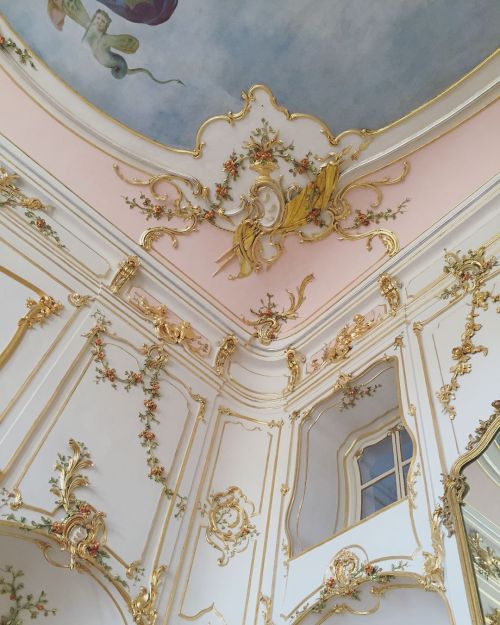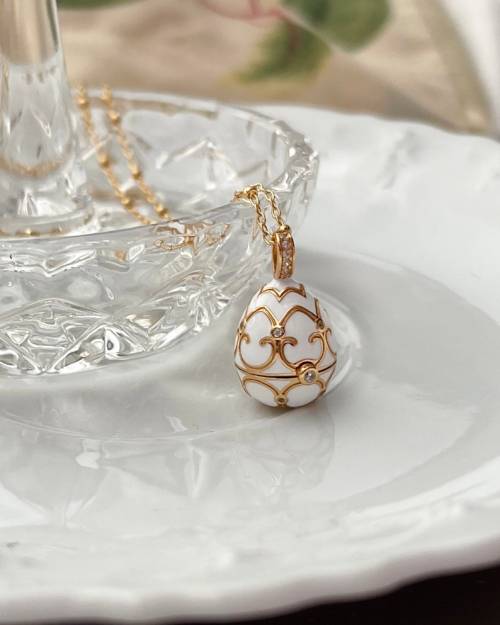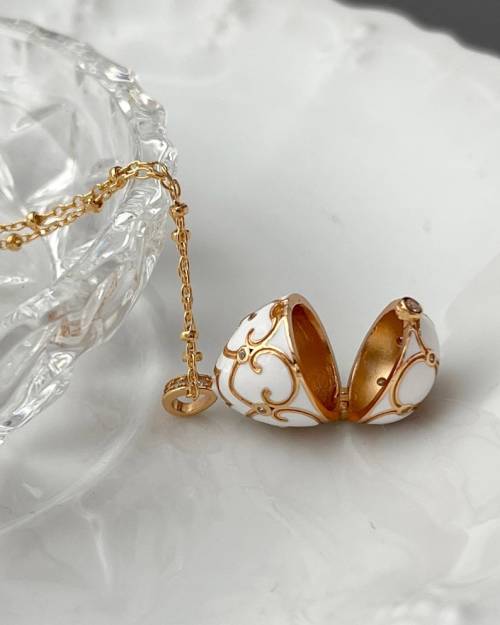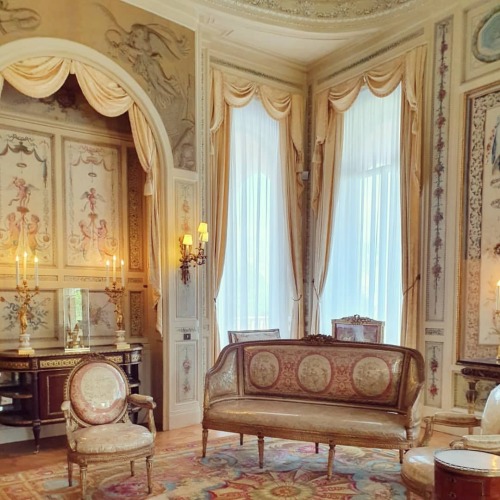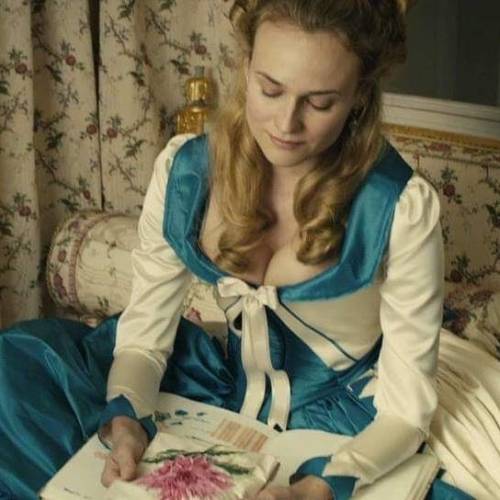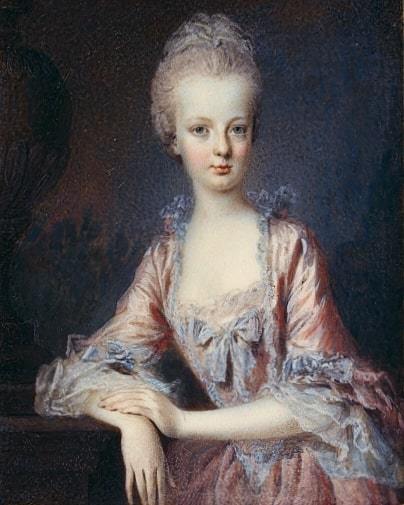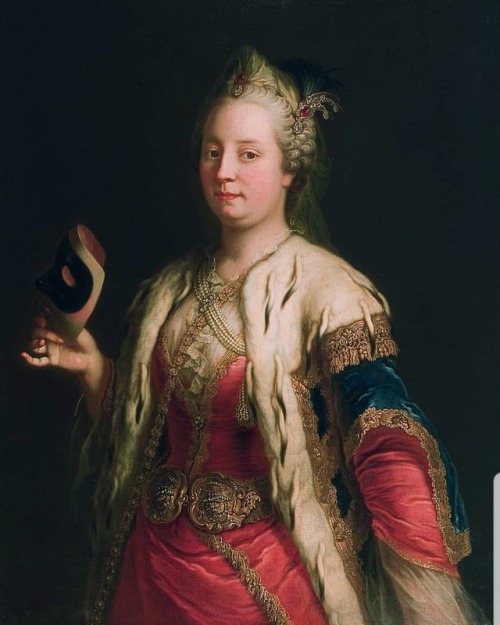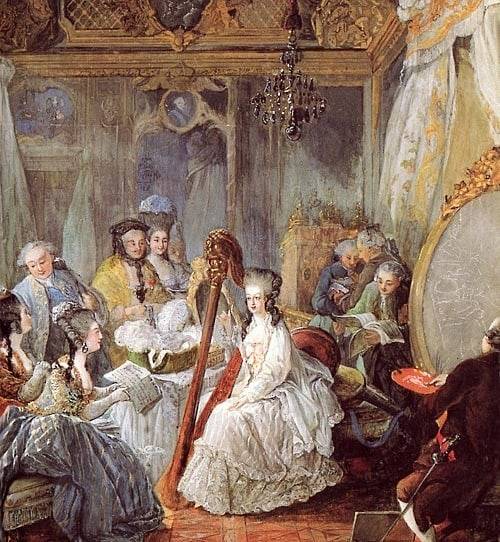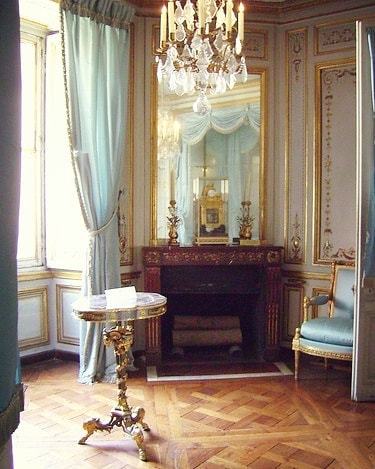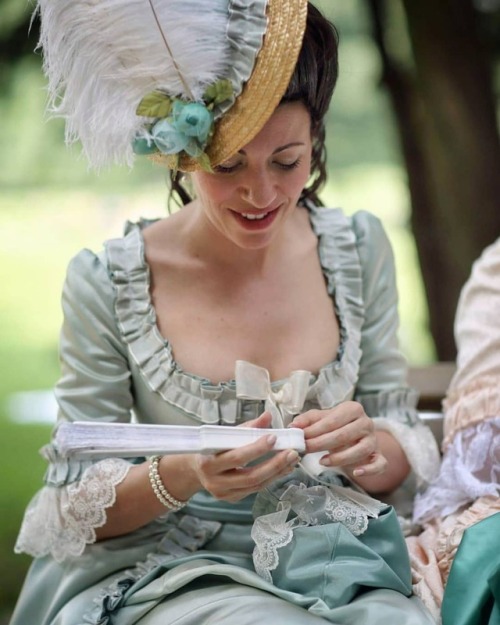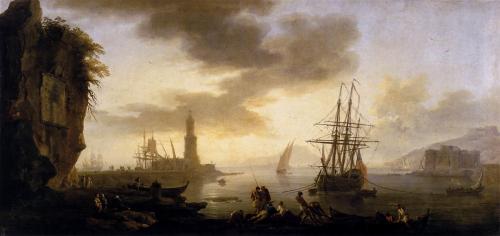#rococo
Villa Ephrussi de Rothschild. Cap Ferrat. Did you know that some forniture collected in this marvellous estate belonged to Marie Antoinette? In my guide dedicated to M.A. I tell you anout this and many other places, all around the world, where you can find some items and souvenir of the Queen.
Thank to my dear friend F. Who sent me this lovely pics last summer, waiting for the day I will finally visit myself this amazing place.
#marieantoinette #mariaantonietta #guidaallaparigidimariaantonietta #villaephrussi #france #coteazur #rococo #18thcenturyinterior #18thcentiryfashion #versailles #marieantoinetteparisguide
https://www.instagram.com/p/B44ycvOIrjM/?igshid=qcn6kkyez89r
Post link
What should I wear today? Gazettes des Atours de la Reine Marie Antoinette for the uear 1782. Every day the Queen chose the 3 dresses of the day by pinning a sample of fabric on this book. In the first pic Diane Kruger as Marie Antoinette in the movie “Farewell my Queen” .
#marieantoinette #18thcenturystyle #18thcenturyfashion #rococo #dress #versailles #dianekruger #farewellmyqueen #lesadiuexalareine #chateaudeversailles #hoteldesoubise #paris
https://www.instagram.com/p/B1-21aXIxLE/?igshid=18nr0rvuwdxcb
Post link
Pink is always a good idea
#pinkdress #pinkweek #18thcenturystyle #18thcentury #ball #baroque #rococo #robealafrancaise #robealanglaise #marieantoinette #robedepoque #versailles #galadhiver #bologna #maskedball #marieantoinettestyle (presso Palazzo Isolani)
https://www.instagram.com/p/B0GyOEToIJS/?igshid=z497fvrl9uz8
Post link
Pink at the Musee Jacquemart-André. Paris
#pinkweek #pink #@jacquemartandre #museum #museumparis #paris #associazioneitalianamariaantonietta #18thcenturyinterior #18thcentury #rococo #portrait #marieantoinette #versailles #mariaantoniettatour #parigi #igparis (presso Musée Jacquemart-André)
https://www.instagram.com/p/B0AkH0KI0ms/?igshid=yufjahpexjej
Post link
Young Marie Antoinette in a pink dress. Hofburg Archives. Wien
#marieantoinette #mariaantonietta #hofburg #wien #rococo #18thcenturystyle #18thcentury #18thcenturyfashion #princess #queen #versailles #portrait #pink #pinkweek (presso Hofburg Imperial Palace)
https://www.instagram.com/p/Bz-fkvrIi1j/?igshid=1cpxj42l3detm
Post link
Maria Teresa with a mask 1744
Martin van Meytens.
Schönbrunn Palace. Vienna
#mariateresa #marietherese #empress #martinvanmeytens #portrait #18thcenturyfashion #18thcentury #rococo #wien #schloss #schonnbrunn #schonnbrunnpalace #marieantoinette #castle #austria #mariateresadaustria #mariatheresia (presso Schloß Schönbrunn)
https://www.instagram.com/p/Bz8zTkfo2TX/?igshid=eytdtsgh2akj
Post link
Chez les Mesdames de France.
@chateauversailles #marieantoinetteparis #marieantoinette #versailles #chateaudeversailles #18thcenturyinterior #18thcenturystyle #rococo #18thcentury #paris #parisinteriors #france #igersversailles (presso Château de Versailles)
https://www.instagram.com/p/Bzi65uPoAIo/?igshid=1ufh85jrmb3bc
Post link
Dress created by the Atelier of Rose Bertin (probably) for the Queen Marie Antoinette (and altereted in the late XIX century) The clothing items belonged to her and survived until today are very very rare so this is an incredible and stunning piece. The dress is now at the Royal Ontario Museum of Toronto.
#marieantoinette #mariaantonietta #marieantoinettedress #rosebertin #royalontariomuseum #rococo #18thcenturyfashion #18thcenturystyle #rococodress #pink #fashion #versailles #chateaudeversailles #royals #robealanglaise #baroque #paris
@carolineweber
https://www.instagram.com/p/BzhoBlOIGVr/?igshid=1dmwgfwregecr
Post link
A brand new upcoming exhibition dedicated to Marie Antoinette will take place at the Conciergerie in Paris next fall. Further details will come out but for now it sounds very interesting…tempted to go and you?
Una nuova mostra dedicata a Maria Antonietta si terrà il prossimo autunno alla Conciergerie di Parigi. Per ora non è trapelato molto su ciò che verrà esposto ma io sono molto tentata…e voi?
#marieantoinette #conciergerie #exhibition #paris #mariaantonietta #mostra #mostre2019 #parigi #rococo #18thcentury #visitparis (presso Conciergerie)
https://www.instagram.com/p/Bzc4sm1oLyd/?igshid=hjao3v3j2h69
Post link
Then and now: Marie Antoinette playing arp in her bedchamber at the Chateau de Versailles. 1777
By D'Agoty
#marieantoinette #chateaudeversailles #versailles #paris #igersversailles #18thcenturyinterior #18thcenturyfashion #rococo #royals #royalpalace #mariaantonietta #portrait #dagoty (presso Château de Versailles)
https://www.instagram.com/p/BzKhuYfIjFZ/?igshid=2irlkgom0als
Post link
Le cabinet de la Meridienne de Marie Antoinette.
Reality vs Painting vs Fiction
Private Appartments. @chateauversailles
#marieantoinette #mariaantonietta #versailles #chateaudeversailles #privateappartment #marieantoinettemovie #kirstendunst #josephcaraud #meridienne #castle #paris #france #rococo #igersversailles #18thcenturyinterior #18thcentury (presso Château de Versailles)
https://www.instagram.com/p/BzF2cAnIl5I/?igshid=5gupasp55zu0
Post link
Cant wait to be in Paris again…
Marie Antoinette Tour.
August 2019
#marieantoinette
#marieantoinetteparis #versaillesecret #versailles #chateaudeversailles #mariaantoniettatour #petittrianon #rococo #18thcenturyinterior #18thcentury #summer2019 #paris #parigi (presso Château de Versailles)
https://www.instagram.com/p/ByzmvGFIADO/?igshid=1ue9sshcfexn0
Post link
Pic nic Royale
Villa Reale di Monza
#villarealemonza #18thcenturyfashion #18thcentury #robealanglaise #marieantoinette #rococo #fetesgalantes #versailles #mariaantonietta #picnic #robedepoque #villa #fashion #royals (presso Reggia di Monza)
https://www.instagram.com/p/Bx9T6nPov0J/?igshid=1mur40i1g1qx8
Post link
Il programma del Maria Antonietta Tour 2019 é in arrivo…siete pronti per questa nuova straordinaria avventura? Stay tuned
#mariaantonietta #mariaantoniettatour #marieantoinette #versailles #summer2019 #chateaudeversailles #paris #igersparis #guidaallaparigidimariaantonietta #marieantoinettetour #rococo (presso Paris, France)
https://www.instagram.com/p/BxfhNGqivdx/?igshid=ocq95duxe6oq
Post link
Fixing my Robe à la Polonaise to make it more ✨historically accurate ✨
With every project I do, I learn more and more about techniques, sewing, and dress history as a whole. So there’s no surprise if I look at an older dress I made and find all kinds of mistakes that need fixing, and I know even in a few months I’ll look at my current projects with the same criticism. Just know that the obvious mistakes are something I’ve been very much aware of since I made it, I just added a fichu because I didn’t know how to fix it.

Here’s the dress. You can immediately tell that something went terribly wrong with the neckline, but there are also some issues with the undergarments that I’m going to deal with.
I made the mistake to cut the neckline straight when it should have been slightly rounded, that’s why it slopes up in the middle. For that, I’m taking out the boning in the front (and later replacing it with actual synthetic whalebone) and folding that slope over to make it rounder. This will however create an even lower neckline which is also one of the many flaws of this dress, so that’s what I dealt with next. Another problem that I had was with one of my sleeves. The right sleeve (left in the picture) wouldn’t lie flat on my shoulders. I have no idea how that happened as I cut both sides the exact same but it’s something I needed to fix so I folded this part over on the inside and stitched it in place.


I did this on both sides so I could raise the neckline as well.
Then I noticed that the front of the bodice wasn’t laying flat, and I noticed that it’s probably too long. I folded the bottom seam over until I felt like it looked flatter and stitched that in place as well. It does look a bit awkward and is not the historically accurate way to fix it, but you can’t really tell from a distance so for the sake of facing my mistakes to practice it was good enough.

The gown still has many more issues that I’d need to make a new one to really make it work so I only tackled the most obvious parts.
There was this big fold in the back that I planned on fixing by resewing the side seam but for some reason after fixing the front it wasn’t so bad after all so I left it as it was.
Now to the petticoats. They’re fine overall, but I didn’t use bands for the ties, I made a tube out of the same fabric, which made it super bulky when tied. And since you have like, two or three of those underneath the actual gown it could make it look a little bulky in the waist area, which I wanted to avoid so I bought some cotton bands about a centimeter wide and replaced all the ties.


This is the fixed dress for now. The back is very boxy so I might resew the side seams after all but this is it for now.




Like I said, to fully fix it I’d just have to make a new one and I will eventually but probably in the distant future as I have many more projects that I want to do. But all in all I can say that I’m really glad I fixed this dress as best as I could because like I said, every project is a big learning experience and fixing something even more so. This way I can make sure I won’t make the same mistakes again!
An Overview of LGBTQA+ Fashions Throughout History
Happy Pride Month, everyone!
In honor of pride month I wanted to research a very particular topic which, unfortunately, isn’t very widely studied. Being part of the LGBTQA+ community myself, I know that we have a very particular way of communicating through fashion, and I was wondering - in a world where homosexuality was punishable by death, how did LGBTQA+ people dress differently, or communicate their sexuality to other members of the community?
As I already mentioned, there is very little known about these things as nobody would openly document how they made others understand they were, for example, into the same sex, but we do know a little.
But first, we have to understand the circumstances in, let’s say, the 18th century.
Homosexuality didn’t really become “a thing” until the late 1800s, as in it didn’t have a label, and it really wasn’t “that big of a deal” in Rococo’s upper class. Not to say it was common, but it was generally common in the upper class to have several sexual partners, and it was not a rare occasion that a rich man's mistress actually turned out to be another man. Though it was technically, by law, punishable by death, the more common punishment for “indecency”, was public humiliation. The fact that it was especially common in the upper class really surprised me, as today’s upper class tends to be much more conservative than the middle or lower class. But I guess it was the wealth that made their sexual encounters be swept under the rug while the lower classes were punished for the exact same things.
A big part of 18th century LGBTQA+ culture were Molly Houses, aka an equivalent of today’s gay bars. Historians assume they first appeared in the middle of the 17th century, but very little is known about them for reasons already mentioned, but they were the place to go if you wanted to meet other LGBTQA+ people. However, if the wrong people found out about them, they would be raided by the police and… you can imagine the consequences.
But now, let’s get to the actual topic: the fashion.
What we know, and what we can even derive from today’s trends, is flamboyance. We know now that some LGBTQA+ people love extravagant fashion as a way to express themselves. I’m saying some because I don’t want to stereotype, and I think it’s awesome that we’re slowly starting to normalize dressing however you want. But flamboyance was key in the 18th century. But now we wonder, in an era where extravagance was everything, what was even more extravagant?
Unfortunately, I only found explanations of how men dressed, but they used an exaggeration of aristocratic costumes and elements from female fashion to express themselves. There are multiple paintings and drawings out there, but I didn’t really want to include any in this post since the ones I found were bordering on (or straight up) caricatures and, if you put it nicely, works of their time. They do give us, however, an idea of what this extravagance could mean as they show people who were perceived as male at the time with high updos and sometimes even completely in traditionally feminine outfits. And in fact, there are mentions of people cross-dressing within the security of Molly Houses, but obviously they wouldn’t do it publicly in a time like this. The only reports are, unfortunately, from police raids and those who did cross dress were given a much harsher punishment than those who didn’t.
Let’s look at a picture of Lord John Harvey, a bisexual man who lived in the 18th century.

When I first saw this picture, I could immediately tell it was different from the rest, I just couldn’t pinpoint exactly what felt so off but then I realized - it was the way his left was just so casually propped on the… thing, and the silk draped over his arm. It’s something I’m used to seeing in female portraits, and it has a sort of sensuality to it that just isn’t common in male portraits. Sure, sometimes there can be a piece of silk draped around a man in a portrait, but I’ve never seen it done like this. I’m not gonna go into the fact that he’s quite literally pointing at his crotch, I don’t know enough about him to say why that is, but you’re free to interpret that however you’d like.
Another interesting 18th century personality I found through my research is Ulrika Eleonora Stålhammar who became a Swedish corporal and married a woman. Long story short, she posed as a man and enlisted in the army, then went on to marry a maid named Maria Löhnman. Löhnman eventually found out about her wife’s gender, but it didn’t matter to her and they stayed together. They were put on trial but claimed they had lived in a marriage without sex and were subsequently acquitted from the charge of homosexuality, but Ulrika still got a sentence for posing as a man and her wife for not revealing the truth. After serving their short sentences (a month and fourteen days, respectively), they lived a quiet life at their family’s estate. Unfortunately, there seems to be no picture of her out there!
I apologize for this short anecdote, I just thought that was really cool and wasn’t expecting not to find a picture, but now let’s get back to the fashion. Another great info I read was that in 18th century Paris, gay men wore shoelaces instead of buckles! Interesting!
Let’s jump forward into the next century. Here’s where flowers become important! The language of flowers was a huge deal in Victorian times, and who would’ve guessed - certain flowers could communicate your sexuality to others. For instance, in 19th century England, the color green indicated homosexuality. Irish author Oscar Wilde, a homosexual man, popularized pinning a green carnation to the lapel.

I’ve seen this picture colorized with the carnation being red but no, it is green so don’t let google fool you!
For women, the color violet and violets became the symbol of same-sex attraction.

These women are wearing 18th century clothing but from what I could find, this is actually an engraving from 1838.
In early 20th century New York, LGBTQA+ men wore red neck ties or bow ties as a subtle signal.
Speaking of early 20th century - I just thought I’d add these adorable pictures of actresses Lily Elsie and Adrienne Augarde. They’re from a show called The New Aladdin, and while neither of them are LGBTQA+ (as far as we know), they’re still worth a mention.


Nowadays, we are more fortunate to be able to be ourselves than these people ever were, and we can be thankful for that without forgetting about the fact that we still have a long way to go. Some countries, unfortunately, haven’t seen any improvements at all. But I also know that being LGBTQA+ even in today’s society can be scary, and sometimes signalizing it through fashion is a lot easier than going up to someone of the same sex and just ask them out. There is this slim line between stereotyping and genuine signals we send, and most of the time we do it so subconsciously that we’re not even aware of it at all times. What I want to say with that is, take my research with a grain of salt. A lot of this information stems from a time when the LGBTQA+ community wasn’t exactly respected and a lot has been interpreted from caricatures. But the most important thing to take from this is that no, LGBTQA+ isn’t just a “modern trend”, we’ve always been there and we always will be. And it’s also important to mention that the reason for me starting my post with the 18th century is that before that, it really wasn’t that big of a deal. In fact, the further back you go, the less of a big deal it was. And while today’s society is still healing from the cruelty that came after, we can thank everyone who came before us for the rights that we do have now. Without them being their brave selves, we wouldn’t be where we are today.
So here are some important historical figures who were part of the LGBTQA+ community.
- Benvenuto Cellini (1500 - 1571), Italian sculptor and goldsmith, homosexual or bisexual
- Pope Julius III (1487-1555), homosexual
- Leonardo da Vinci (1452-1519), Italian painter, homosexual
- William Shakespeare (1564-1616), playwright, probably bisexual
- Thomas Cannon (18th century) author, wrote the first defense of homosexuality
- Johann Joachim Winckelmann (1717-1768), German art historian, homosexual
- Anne Lister (1791-1840), diarist, “first modern lesbian"
- Walter Whitman (1819-1892), poet, homosexual or bisexual
- Oscar Wilde (1854-1900), poet and playwright, homosexual
- Vincent Van Gogh (1853-1890), painter, bisexual
- Josephine Baker (1906-1975), entertainer, bisexual
- Virginia Woolf (1882-1941), writer, bisexual
- Bayard Rustin (1912-1987), African American leader in civil rights, socialism, nonviolence and gay righs, homosexual
- Frida Kahlo (1907-1954), painter, bisexual
White Wedding Dresses Throughout History
The rumor that Queen Victoria started the “white wedding dress trend” is so widely spread that many people don’t question it, but while it is somewhat true, it’s not the full truth and here’s why.
It is true that after Queen Victoria’s marriage in 1840, the white wedding dress gained popularity up until in the late 19th century, when it became a standard color for wedding gowns. However, white wedding dresses already existed prior to that.
I’m starting this wedding dress history in the 18th century, when a wedding was less about love and romance and more about politics, so a wedding was the perfect opportunity for the bride to showcase her status, and since white fabrics were generally more expensive and rarer than other colors, it was a popular choice. However, that doesn’t mean that other vibrant colors and/or prints weren’t just as popular back then, if not even more.
But since I’m focusing on white dresses in this post and I will make a separate post on non-white wedding dresses soon, here are two examples of an 18th century wedding dress.
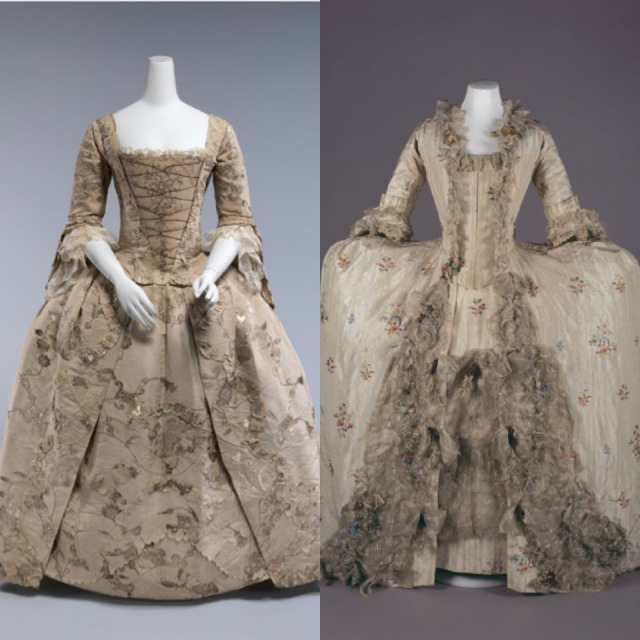
The first one from 1747 is a Robe à l’Anglaise, the second one from 1775 a Française. As you can see, they both have trimmings and decorations and that is because the focus wasn’t on making the dress white as it is today, it was more about showcasing what you were able to afford, so intricate trimmings and embroidery were the way to go. People would also continue to wear their wedding dresses for other special occasions, it wasn’t really an exclusive garment that you’d only wear once. Maybe the super affluent ones could actually afford to do that, but it was way more common than not to wear one’s wedding dress to other events, as the wedding dress wasn’t really a separate type of dress but rather just a more expensive version of a formal dress.
The early 19th century brought light muslin dresses, so a lot of special occasion dresses were already white. In the later regency decades, these muslin wedding dresses were more intricately decorated with embroidery for example, as shown in these beautiful extent pieces from 1807 and ca. 1830.

I couldn’t possibly make this post without including Queen Victoria’s wedding dress.


I read that the reason the white dress was such a big deal was because she was expected to wear the crimson velvet robe of the state. Instead, she announced that on her wedding day she would focus on being Albert’s future wife rather than the monarch and chose to wear a white dress as a symbol of innocence and romance. But either way, the monarchs were the fashion icons of that time, so it’s no wonder those who could afford it started to wear similar things to the queen.
Moving on to the next decade, here is a lovely muslin wedding dress from 1851.

It’s a very down to earth dress, not very flashy and it’s interesting to note the gathered/smocked front as it’s something that was very popular during the 1840s and very early 50s.
From the 60s, we have this pretty light beige dress, and yes I know I said white dresses only but none of them are perfectly white so I think I’ll let it pass.

Notice how all of the dresses so far strictly follow the fashion trends of that time? I think it’s really interesting if you compared it to today because it would essentially be the equivalent of just wearing a white version of a semi-formal outfit, which isn’t really a thing and shouldn’t be in my opinion. I’m all for wear what you want but I feel like we’ve already lost the charme of beautiful fancy outfits and I’m glad we still have the traditional white gown for weddings at least. If you’re already wearing fancy gowns on a daily basis, obviously the only thing you can do to make it stand out is make it white (or any other uncommon color for that matter). I would also like to mention that when I came up with the idea to write about wedding gowns I was expecting them to be white versions of evening/ball gowns but they’re mostly just day dresses. Very surprising I think.
For the 1870s I have two examples, since one is strictly speaking not white and they’re both really lovely and worth a mention.

You can totally see the completely different styles and approaches even though they were made within two years from each other. I also really adore the leaf trimmings and the sheer (-looking?) fabric. What I don’t love though is the robe-like front, it looks a little too casual for my taste.
Let’s move on to the 80s with this gown.

Now, that’s what I call a wedding dress! It’s not too casual, it’s most definitely fancy and those pearl accents- It really reminds me of Worth’s work with pearls (I am seriously contemplating making a post just showing pictures of Worth gowns with pearl decoration cause those are my absolute favorite thing) but it was actually made by Messrs Gladman and Womack in 1885 and has never been altered.
Alright, next up we have the 90s, another amazing decade in fashion and I couldn’t possibly not include a Worth gown.

Here you can see actual high fashion of the time. The princess cut had already been popular since the 70s but by the 90s, it was mostly reserved for formal wear. I don’t know what it is that’s so pleasing about this dress, something about the shapes, they’re so balanced and perfect. It always amazes me how Worth can work with seemingly plain colors/without much decoration but have the result still outshine every other dress. Maybe there’s even something contemporary in this dress - it doesn’t represent the typical “kitsch” we associate with the Victorian era, like the 1880s piece for example which is an almost stereotypical example of everything fashionable in the mid 80s. It’s none of that, but at the same time it’s everything.
And finally, I couldn’t possibly leave out my favorite decade—

You got it. The 1900s.
Once again, it just looks like a white, fancy version of the day dress but notice how it has a really long train. Trains did become a thing again in the Edwardian era but weren’t that long for everyday wear. A lot of the examples above also have a longer than normal train, which was common for formal court gowns and the trend of having a long train stuck to this day! I think it’s really fascinating to look at old trends and analyze how they affect how we dress today. You might find more similarities than you’d expect.
Anyways, that is it for now. I hope I can actually get more consistent with my posting because I have quite a few ideas but I am also starting uni again next week after my semester break so we’ll see how that goes. Super nervous about it but I’m also excited!

